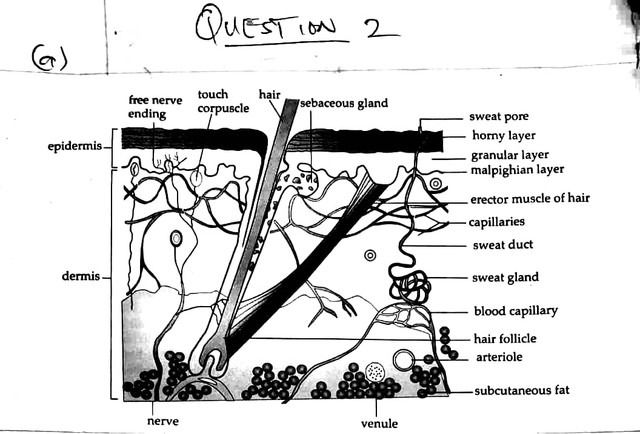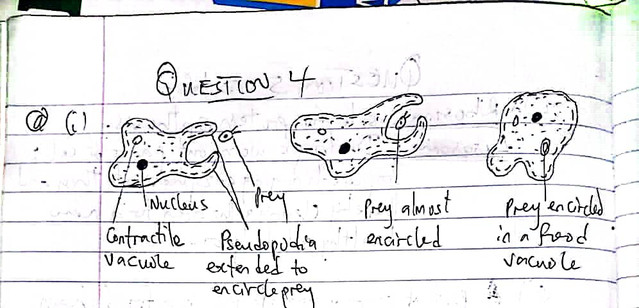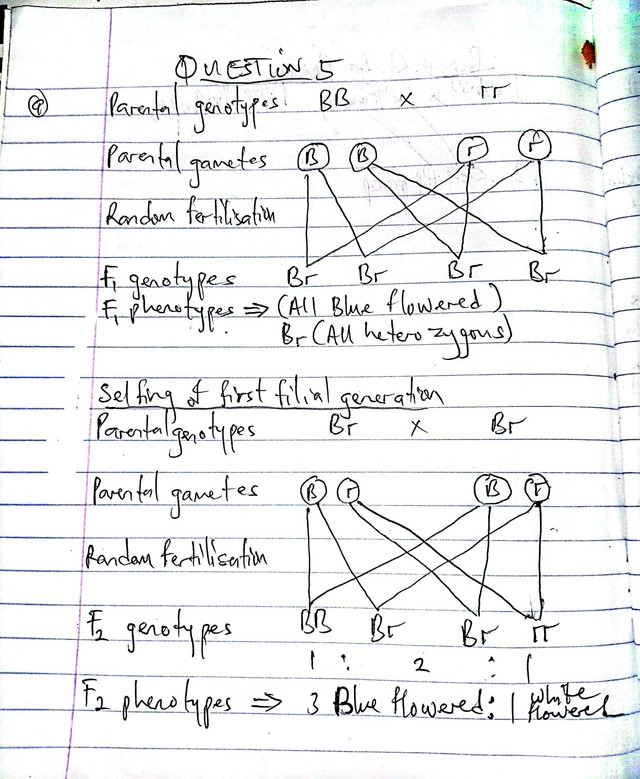NECO Biology OBJ 2025
01-10: DEBEBDCDAE
11-20: CCAABBBDBE
21-30: BAACEECEAC
31-40: BBDEABDEBD
41-50: DEAEEABDBE
51-60: CEBACDDCEC
COMPLETED!!!
NECO Biology Essay 2025
Number 1
(1a)
(i) Calyx
(ii) Corolla
(iii) Androecium
(iv) Gynoecium
(1bi)
(i) Protein digestion begins in the stomach, where hydrochloric acid (HCl) creates an acidic environment that activates pepsinogen into pepsin, an enzyme that breaks large protein molecules into smaller units called peptides.
(ii) In the duodenum, enzymes from the pancreas like trypsin and chymotrypsin continue the breakdown of peptides into smaller peptides.
(iii) In the ileum, enzymes called peptidases (produced by the intestinal walls) further break these smaller peptides into amino acids.
(iv) The amino acids are then absorbed through the walls of the small intestine into the bloodstream, where they are transported to body cells for growth, repair, and energy.
(1bii)
(i) Collenchyma
(ii) Sclerenchyma
(iii) Parenchyma
(1ci)
in a Tabular form
=Mitosis=
(PICK ANY TWO)
(i) It occurs in somatic (body) cells.
(ii) It produces two daughter cells.
(iii) The daughter cells are diploid (2n).
(iv) Homologous chromosomes do not pair or cross over.
(v) There is no genetic variation in the daughter cells.
(vi) It involves only one cell division.
=Meiosis=
(PICK ANY TWO)
(i) It occurs in reproductive (sex) cells.
(ii) It produces four daughter cells.
(iii) The daughter cells are haploid (n).
(iv) Homologous chromosomes pair and may cross over.
(v) It leads to genetic variation in the daughter cells.
(vi) It involves two successive cell divisions.
(1cii)
(PICK ANY THREE)
(i) Enzymes are biological catalysts that speed up chemical reactions.
(ii) They are highly specific to the reactions they act on.
(iii) Enzymes are not used up during reactions—they can be reused.
(iv) They work best at a particular (optimum) temperature.
(v) Enzyme activity is affected by changes in pH.
(vi) Enzymes are made up of proteins.
==================
Number 2
(2a)

(2bi)
=Air pollutants=
(PICK ANY TWO)
(i) Carbon monoxide (CO)
(ii) Sulphur dioxide (SO₂)
(iii) Nitrogen oxides (NOx)
(iv) Smoke (soot)
(v) Chlorofluorocarbons (CFCs)
(vi) Dust particles
=Water pollutants=
(PICK ANY TWO)
(i) Sewage
(ii) Industrial waste
(iii) Oil spills
(iv) Heavy metals (e.g, mercury, lead)
(v) Detergents
(vi) Pesticides
(2bii)
(PICK ANY FOUR)
(i) Marginal
(ii) Axile
(iii) Parietal
(iv) Basal
(v) Free central
(vi) Superficial
(2c)
(PICK ANY FOUR)
(i) Use of condoms
(ii) Use of birth control pills (oral contraceptives)
(iii) Intrauterine devices (IUDs)
(iv) Surgical methods (vasectomy or tubal ligation)
(v) Use of contraceptive implants
(vi) Use of contraceptive injections
(vii) Use of spermicides
(viii) Withdrawal method (coitus interruptus)
==================
Number 3
(3a)
(i) During the day, guard cells absorb water by osmosis, becoming turgid.
(ii) The inner walls of guard cells are thicker and less flexible, so the cells bend outward.
(iii) This creates an opening called the stomatal pore—the stomata open.
(iv) At night or during water shortage, guard cells lose water and become flaccid.
(v) As they shrink, the stomatal pore closes.
(vi) This opening and closing helps regulate gas exchange and water loss through transpiration.
(3bi)
(PICK ANY THREE)
(i) Temperature
(ii) Light intensity
(iii) Water availability
(iv) Soil type
(v) pH
(vi) Humidity
(3bii)
(i) Kidneys
(ii) Lungs
(iii) Skin
(3ci)
(PICK ANY FOUR)
(i) Withdrawal of hand from a hot object
(ii) Blinking of the eyes
(iii) Knee-jerk reflex
(iv) Sneezing
(v) Coughing
(vi) Pupil constriction in bright light
(3cii)
Chromosomes are regarded as the basis of heredity because they carry genes, which are the functional units of inheritance. These genes contain the information needed to determine traits and are passed from parents to offspring through the gametes during reproduction. Each gene controls a specific characteristic such as eye color, height, or blood group. The combination and interaction of these genes determine the genetic makeup of an individual. Therefore, chromosomes serve as the carriers of hereditary information from one generation to the next.
==================
Number 4
(4ai)

=PROCESS IN AMOEBA=
(i) Amoeba feeds through phagocytosis, a process where it engulfs food using pseudopodia.
(ii) The pseudopodia extend and surround the food particle.
(iii) The food is enclosed in a food vacuole.
(iv) Inside the vacuole, digestive enzymes break down the food.
(v) The nutrients are absorbed into the cytoplasm and the undigested waste is expelled.
(4aii)
Hypermetropia (long-sightedness) is an eye defect where a person can see distant objects clearly but has difficulty seeing near objects because light rays are focused behind the retina. It is corrected using a convex lens.
(4bi)
(PICK ANY FOUR)
(i) They are brightly coloured petals to attract insects
(ii) They are presence of nectar
(iii) They have Large and scented flowers
(iv) Sticky or spiny pollen grains
(v) Stiff and firm stamens
(vi) They have sticky stigma to trap pollen
(4bii)
(PICK ANY FOUR)
(i) Destruction of farmlands
(ii) Loss of lives and property
(iii) Soil erosion
(iv) Water contamination
(v) Displacement of people
(vi) Outbreak of waterborne diseases
(vii) Destruction of infrastructure
(viii) Loss of soil fertility
(4c)
(PICK ANY FIVE)
(i) Auxins
(ii) Gibberellins
(iii) Cytokinins
(iv) Abscisic acid
(v) Ethylene
(vi) Florigen
(vii) Brassinosteroids
(viii) Jasmonates
==================
Number 5
(5a)

=Ribosome=
(PICK ANY ONE)
(i) Site of protein synthesis
(ii) Links amino acids to form polypeptides
(iii) Found on rough endoplasmic reticulum
(iv) Helps in enzyme production
(v) Assists in repairing cell damage
(vi) Translates mRNA into proteins
=Lysosome=
(PICK ANY ONE)
(i) Digests worn-out organelles
(ii) Breaks down engulfed bacteria or viruses
(iii) Carries digestive enzymes
(iv) Helps in autolysis (self-destruction of cell)
(v) Breaks down macromolecules
(vi) Assists in recycling cell materials
(5bii)
As energy is transferred from one trophic level to the next, a large portion is lost as heat, used in metabolism, movement, and other activities. Only about 10% of the energy is passed on, leading to a progressive decrease in energy available at higher levels.
(5biii)
(PICK ANY TWO)
(i) Presence of water molecules
(ii) A semipermeable membrane
(iii) Two regions with different water concentrations
(iv) One region with a higher water potential
(v) One region with a lower water potential
(vi) No energy input required (passive process)
(5c)
(PICK ANY FIVE)
(i) Crop rotation
(ii) Contour ploughing
(iii) Terracing
(iv) Mulching
(v) Afforestation (planting trees)
(vi) Cover cropping
(vii) Strip farming
(viii) Controlled grazing
COMPLETED!!!
